Reinforcement of Injectable Hydrogel for Meniscus Tissue Engineering by Using Cellulose Nanofiber from Cassava Pulp
Abstract
1. Introduction
2. Materials and Methods
2.1. Materials
2.2. Preparation of CNF
2.3. Preparation of CNF-Reinforced PEO-PPO-PEO-DA/GelMA Injectable Hydrogels
2.4. Preparation of Fibrin Glue
2.5. Characterization of Cellulose Nanofiber
2.5.1. Morphology, Diameter, and Length
2.5.2. Structure
2.5.3. Crystallinity
2.6. Physicochemical Characterization of Injectable Hydrogel
2.6.1. Morphology and Pore Size Diameter
2.6.2. Porosity
2.6.3. Gel Fraction
2.6.4. Water Uptake and Swelling
2.6.5. Mechanical Properties
2.6.6. Chemical Composition and Interactions
2.7. In Vitro Cell Culture Studies
2.7.1. Cell Cytotoxicity
2.7.2. Cell Proliferation
2.8. Statistical Analysis
3. Results and Discussion
3.1. Characterization of Cellulose Nanofiber
3.2. Effect of CNF Concentration on Physicochemical Properties of PEO-PPO-PEO-DA Injectable Hydrogels
3.3. Characterization of CNF-Reinforced PEO-PPO-PEO-DA/GelMA Injectable Hydrogels
3.3.1. Physicochemical Characterization
Appearance
Morphology, Pore Size Diameter, and Porosity
Gel Fraction, Water Uptake, and Swelling
Mechanical Properties
Chemical Interaction
3.3.2. In Vitro Cell Culture Studies
Cell Cytotoxicity
Cell Proliferation
4. Conclusions
Author Contributions
Funding
Institutional Review Board Statement
Data Availability Statement
Acknowledgments
Conflicts of Interest
References
- Noori, A.; Ashrafi, S.J.; Vaez-Ghaemi, R.; Hatamian-Zaremi, A.; Webster, T.J. A review of fibrin and fibrin composites for bone tissue engineering. Int. J. Nanomed. 2017, 12, 4937–4961. [Google Scholar] [CrossRef]
- Zhang, H.; Ren, P.; Jin, Y.; Ren, F. Injectable, strongly compressible hyaluronic acid hydrogels via incorporation of Pluronic F127 diacrylate nanomicelles. Mater. Lett. 2019, 243, 112–115. [Google Scholar] [CrossRef]
- Li, Y.; Wang, Y.; Shene, C.; Meng, Q. Non-swellable F127-DA hydrogel with concave microwells for formation of uniform-sized vascular spheroids. RSC Adv. 2020, 10, 44494–44502. [Google Scholar] [CrossRef] [PubMed]
- Voisin, H.; Bergström, L.; Liu, P.; Mathew, A.P. Nanocellulose-Based Materials for Water Purification. Nanomaterials 2017, 7, 57. [Google Scholar] [CrossRef]
- Qingxiu, L.; Liu, J.; Qin, S.; Pei, S.; Zheng, X.; Tang, K. High mechanical strength gelatin composite hydrogels reinforced by cellulose nanofibrils with unique beads-on-a-string morphology. Int. J. Biol. Macromol. 2020, 164, 1776–1784. [Google Scholar]
- Doench, I.; Tran, T.A.; David, L.; Montembault, A.; Viguier, E.; Gorzelanny, C.; Sudre, G.; Cachon, T.; Louback-Mohamed, M.; Horbelt, N.; et al. Cellulose nanofiber-reinforced chitosan hydrogel composites for intervertebral disc tissue repair. Biomimetics 2019, 4, 19. [Google Scholar] [CrossRef]
- Aarstad, O.; Heggset, E.B.; Pedersen, I.S.; Bjørnøy, S.H.; Syverud, K.; Strand, B.L. Mechanical properties of composite hydrogels of alginate and cellulose nanofibrils. Polymers 2017, 9, 378. [Google Scholar] [CrossRef] [PubMed]
- Kim, H.J.; Oh, D.X.; Choy, S.; Nguyen, H.-L.; Cha, H.J.; Hwang, D.S. 3D cellulose nanofiber scaffold with homogeneous cell population and long-term proliferation. Cellulose 2018, 25, 7299–7314. [Google Scholar] [CrossRef]
- Howeler, R. Cassava in Asia: A potential new green revolution in the making. In A New Future for Cassava in Asia. Its Use as Food, Feed and Fuel to Benefit the Poor: Proceedings of the 8th Regional Workshop, Vientiane, Lao, 20–24 October 2008; Howeler, R., Ed.; CIAT, Cassava Program: Bangkok, Thailand, 2010; pp. 34–65. [Google Scholar]
- Ruangudomsakul, W.; Ruksakulpiwat, C.; Ruksakulpiwat, Y. Preparation and characterization of cellulose nanofibers from cassava pulp. Macromol. Symp. 2015, 354, 170–176. [Google Scholar] [CrossRef]
- Lerdlattaporn, R.; Phalakornkule, C.; Ruenglertpanyakul, W.; Lueangwattanapong, K.; Songkasiri, W. Economic and environmental assessment of different biogas conversion technologies for cassava pulp treatment in Thailand: A case study. IOP Conf. Ser. Earth Environ. Sci. 2022, 1050, 012011. [Google Scholar] [CrossRef]
- Wang, F.; Li, Y.; Shen, Y.; Wang, A.; Wang, S.; Xie, T. The functions and applications of RGD in tumor therapy and tissue engineering. Int. J. Mol. Sci. 2013, 14, 13447–13462. [Google Scholar] [CrossRef] [PubMed]
- Piao, Y.; You, H.; Xu, T.; Bei, H.P.; Piwko, I.Z.; Kwan, Y.Y.; Zhao, X. Biomedical applications of gelatin methacryloyl hydrogels. Eng. Regen. 2021, 2, 47–56. [Google Scholar] [CrossRef]
- Celikkin, N.; Mastrogiacomo, S.; Jaroszewicz, J.; Walboomers, X.F.; Swieszkowski, W. Gelatin methacrylate scaffold for bone tissue engineering: The influence of polymer concentration. J. Biomed. Mater. Res. A 2018, 106, 201–209. [Google Scholar] [CrossRef] [PubMed]
- Wu, J.; Ding, Q.; Dutta, A.; Wang, Y.; Huang, Y.-H.; Weng, H.; Tang, L.; Hong, Y. An injectable extracellular matrix derived hydrogel for meniscus repair and regeneration. Acta Biomater. 2015, 16, 49–59. [Google Scholar] [CrossRef] [PubMed]
- An, Y.-H.; Kim, J.-A.; Yim, H.-G.; Han, W.-J.; Park, Y.-B.; Park, H.J.; Kim, M.Y.; Jang, J.; Koh, R.H.; Kim, S.-H.; et al. Meniscus regeneration with injectable Pluronic/PMMA-reinforced fibrin hydrogels in a rabbit segmental meniscectomy model. J. Tissue Eng. 2021, 12, 20417314211050141. [Google Scholar] [CrossRef] [PubMed]
- Kim, J.-A.; An, Y.-H.; Yim, H.-G.; Han, W.-J.; Park, Y.-B.; Park, H.J.; Kim, M.Y.; Jang, J.; Koh, R.H.; Kim, S.-H.; et al. Injectable fibrin/polyethylene oxide semi-IPN hydrogel for a segmental meniscal defect regeneration. Am. J. Sports Med. 2021, 49, 1538–1550. [Google Scholar] [CrossRef] [PubMed]
- Numpaisal, P.-O.; Rothrauff, B.B.; Gottardi, R.; Chien, C.L.; Tuan, R.S. Rapidly dissociated autologous meniscus tissue enhances meniscus healing: An in vitro study. Connect. Tissue Res. 2016, 58, 355–365. [Google Scholar] [CrossRef]
- Segal, L.; Creely, J.J.; Martin, A.E.; Conrad, C.M. An empirical method for estimating the degree of crystallinity of native cellulose using the X-Ray diffractometer. Text. Res. J. 1959, 29, 786–794. [Google Scholar] [CrossRef]
- Wicaksono, R.; Syamsu, K.; Yuliasih, I.; Nasir, M. Cellulose nanofibers from cassava bagasse: Characterization and application on tapioca-film. Chem. Mater. Res. 2013, 3, 79–87. [Google Scholar]
- Widiarto, S.; Pramono, E.; Rochliadi, A.; Arcana, I.M. Cellulose nanofibers preparation from cassava peels via mechanical disruption. Fibers 2019, 7, 44. [Google Scholar] [CrossRef]
- Kramschuster, A.; Turng, L.S. 17-Fabrication of Tissue Engineering Scaffolds. In Handbook of Biopolymers and Biodegradable Plastics; Ebnesajjad, S., Ed.; William Andrew Publishing: Boston, MA, USA, 2013; pp. 427–446. [Google Scholar]
- Meng, L.; Shao, C.; Cui, C.; Xu, F.; Lei, J.; Yang, J. Autonomous self-healing silk fibroin injectable hydrogels formed via surfactant-free hydrophobic association. ACS Appl. Mater. Interfaces 2020, 12, 1628–1639. [Google Scholar] [CrossRef]
- Wang, B.; Liu, J.; Niu, D.; Wu, N.; Yun, W.; Wang, W.; Zhang, K.; Li, G.; Yan, S.; Xu, G.; et al. Mussel-inspired bisphosphonated injectable nanocomposite hydrogels with adhesive, self-healing, and osteogenic properties for bone regeneration. ACS Appl. Mater. Interfaces 2021, 13, 32673–32689. [Google Scholar] [CrossRef] [PubMed]
- Bi, S.; Wang, P.; Hu, S.; Li, S.; Pang, J.; Zhou, Z.; Sun, G.; Huang, L.; Cheng, X.; Xing, S.; et al. Construction of physical-crosslink chitosan/PVA double-network hydrogel with surface mineralization for bone repair. Carbohydr. Polym. 2019, 224, 115176. [Google Scholar] [CrossRef] [PubMed]
- Li, R.; Zhou, C.; Chen, J.; Luo, H.; Li, R.; Chen, D.; Zou, X.; Wang, W. Synergistic osteogenic and angiogenic effects of KP and QK peptides incorporated with an injectable and self-healing hydrogel for efficient bone regeneration. Bioact. Mater. 2022, 18, 267–283. [Google Scholar] [CrossRef]
- Jiang, Y.; Wang, H.; Wang, X.; Yu, X.; Li, H.; Tang, K.; Li, Q. Preparation of gelatin-based hydrogels with tunable mechanical properties and modulation on cell-matrix interactions. J. Biomater. Appl. 2021, 36, 902–911. [Google Scholar] [CrossRef]
- National Center for Biotechnology Information. PubChem Patent Summary for US-7008635-B1, H.f.o.r.R.J. 2023. Available online: https://pubchem.ncbi.nlm.nih.gov/patent/US-7008635-B1 (accessed on 25 December 2022).
- Cui, S.; Zhang, S.; Coseri, S. An injectable and self-healing cellulose nanofiber-reinforced alginate hydrogel for bone repair. Carbohydr. Polym. 2023, 300, 120243. [Google Scholar] [CrossRef] [PubMed]
- Ozmen, M.M.; Okay, O. Superfast responsive ionic hydrogels: Effect of the monomer concentration. J. Macromol. Sci. A 2006, 43, 1215–1225. [Google Scholar] [CrossRef]
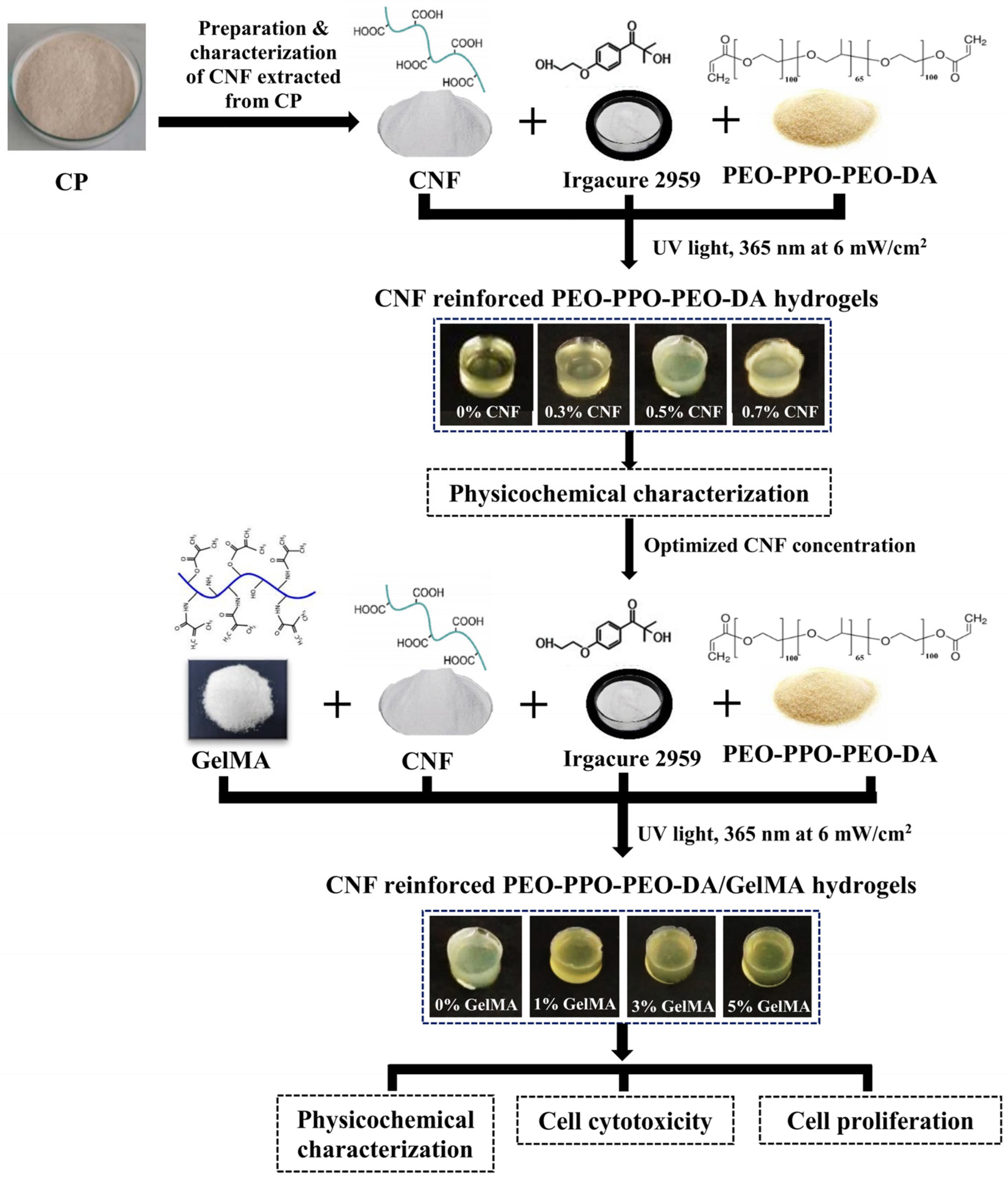



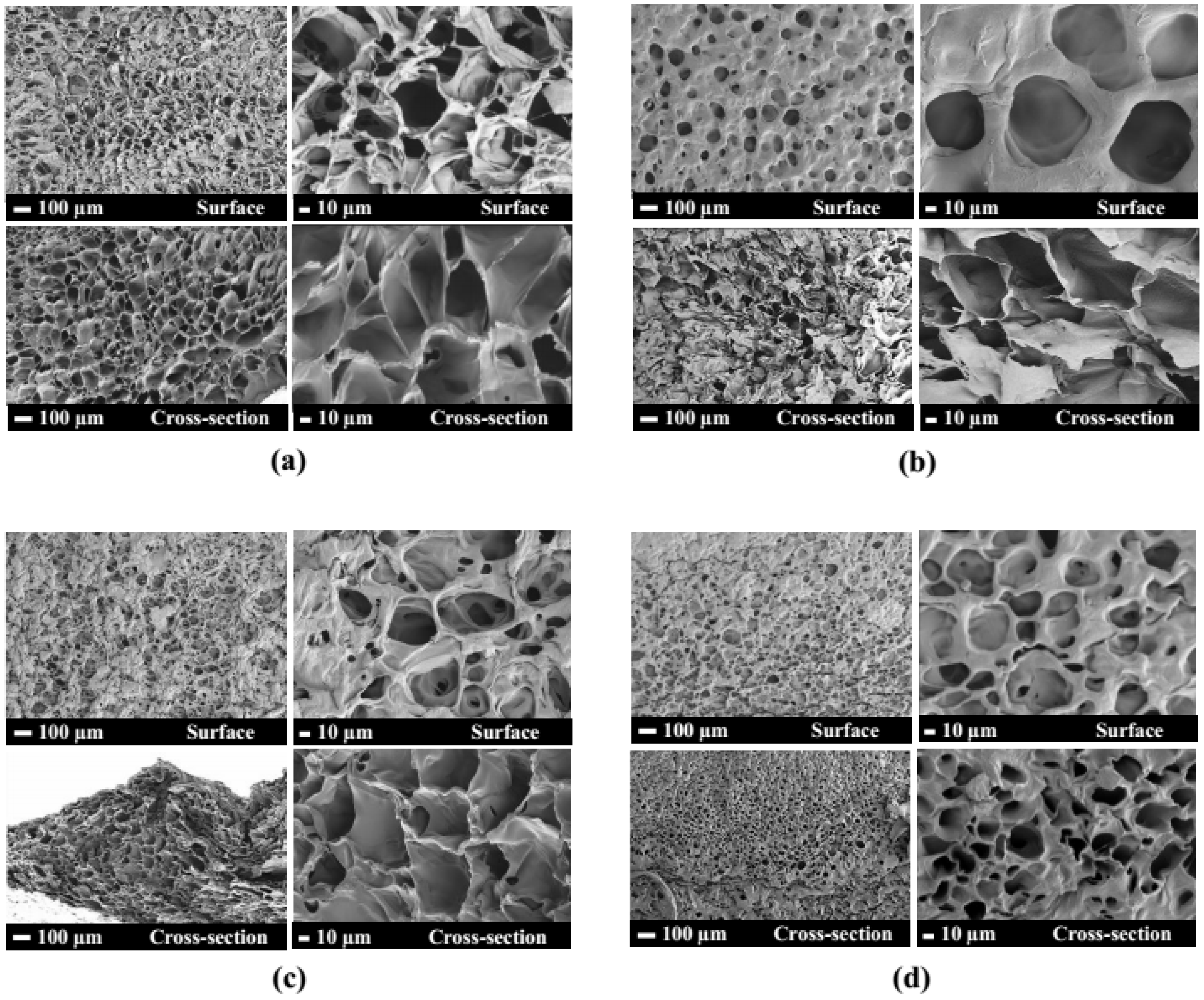
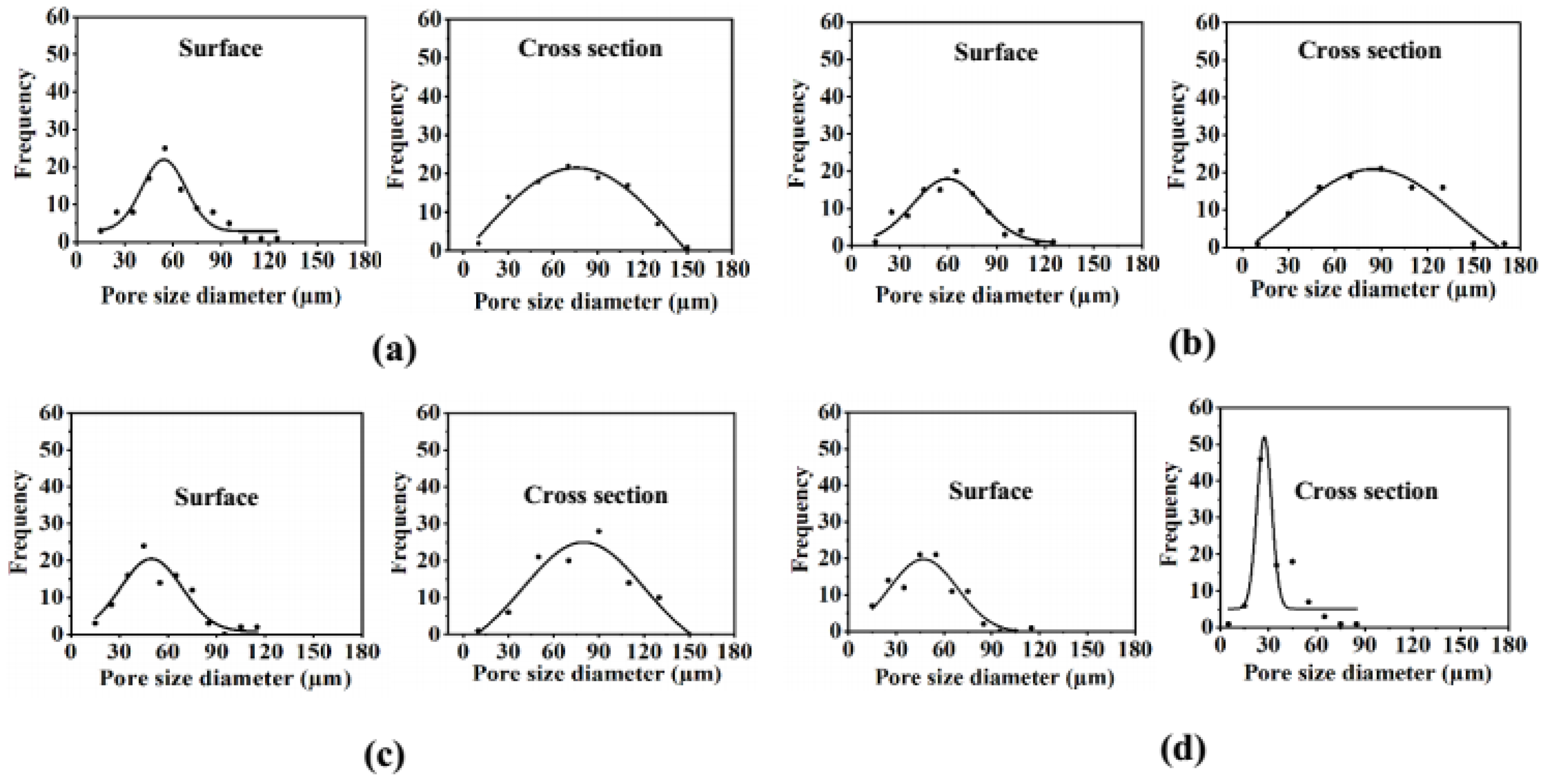
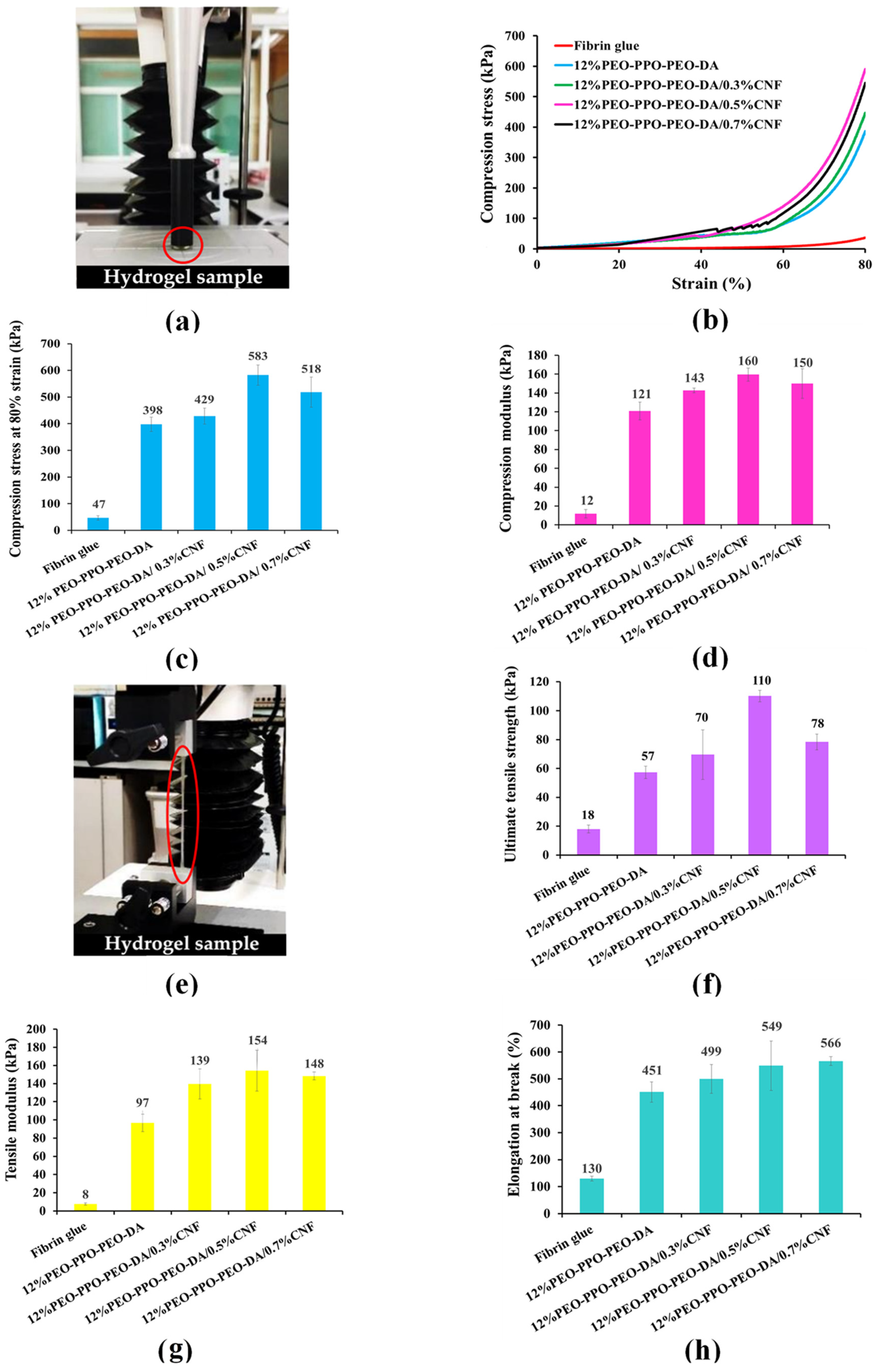

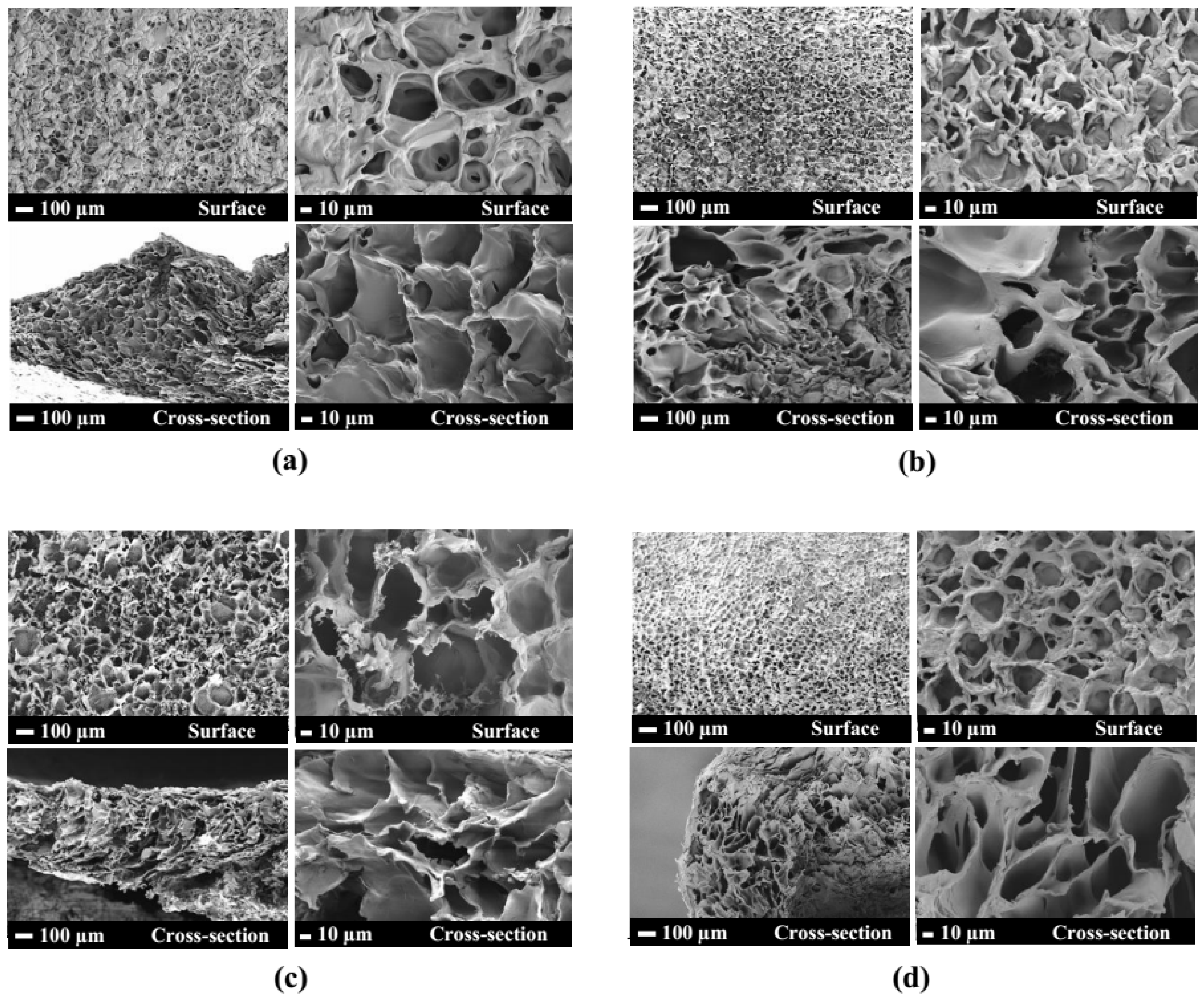
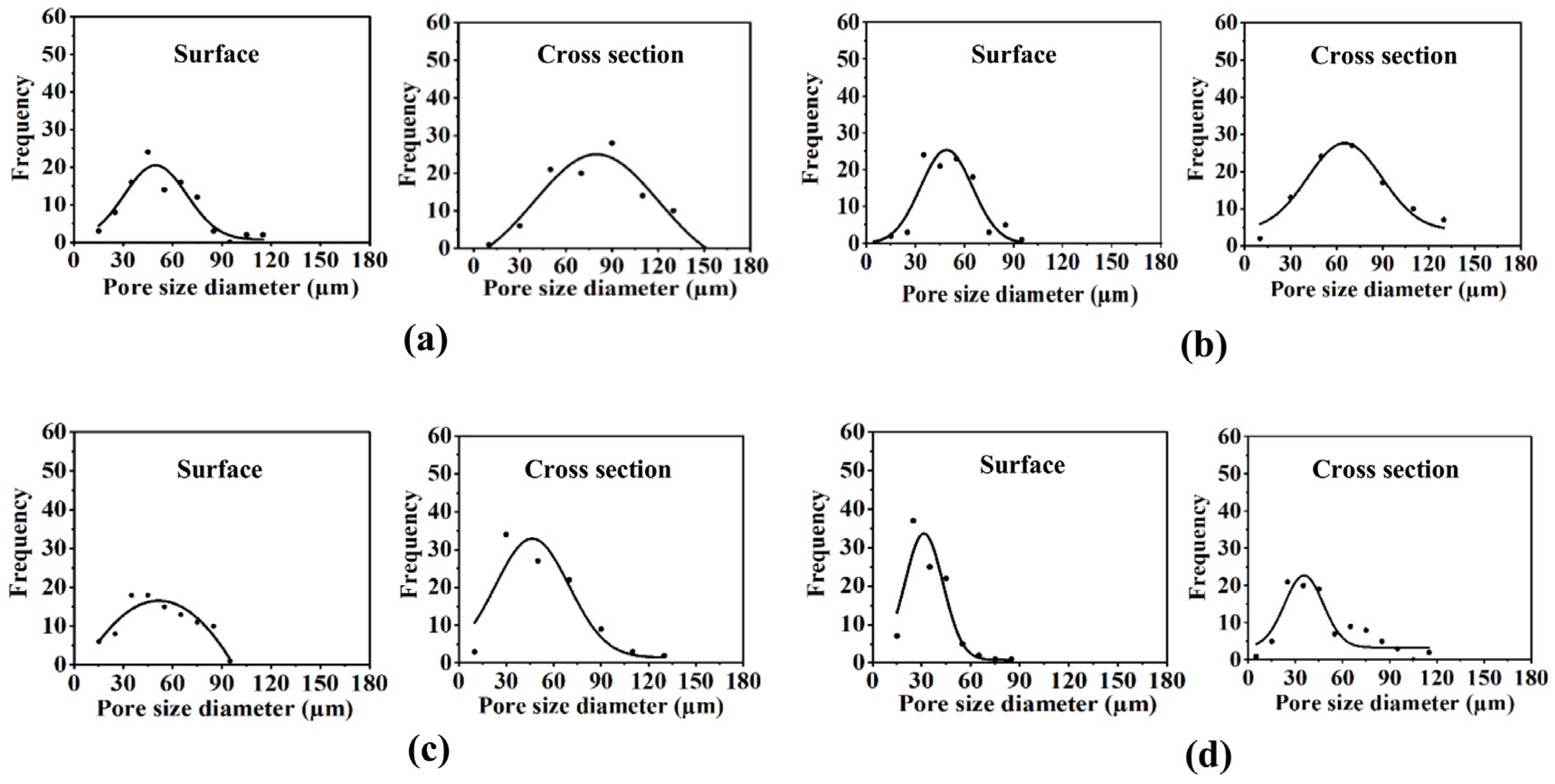
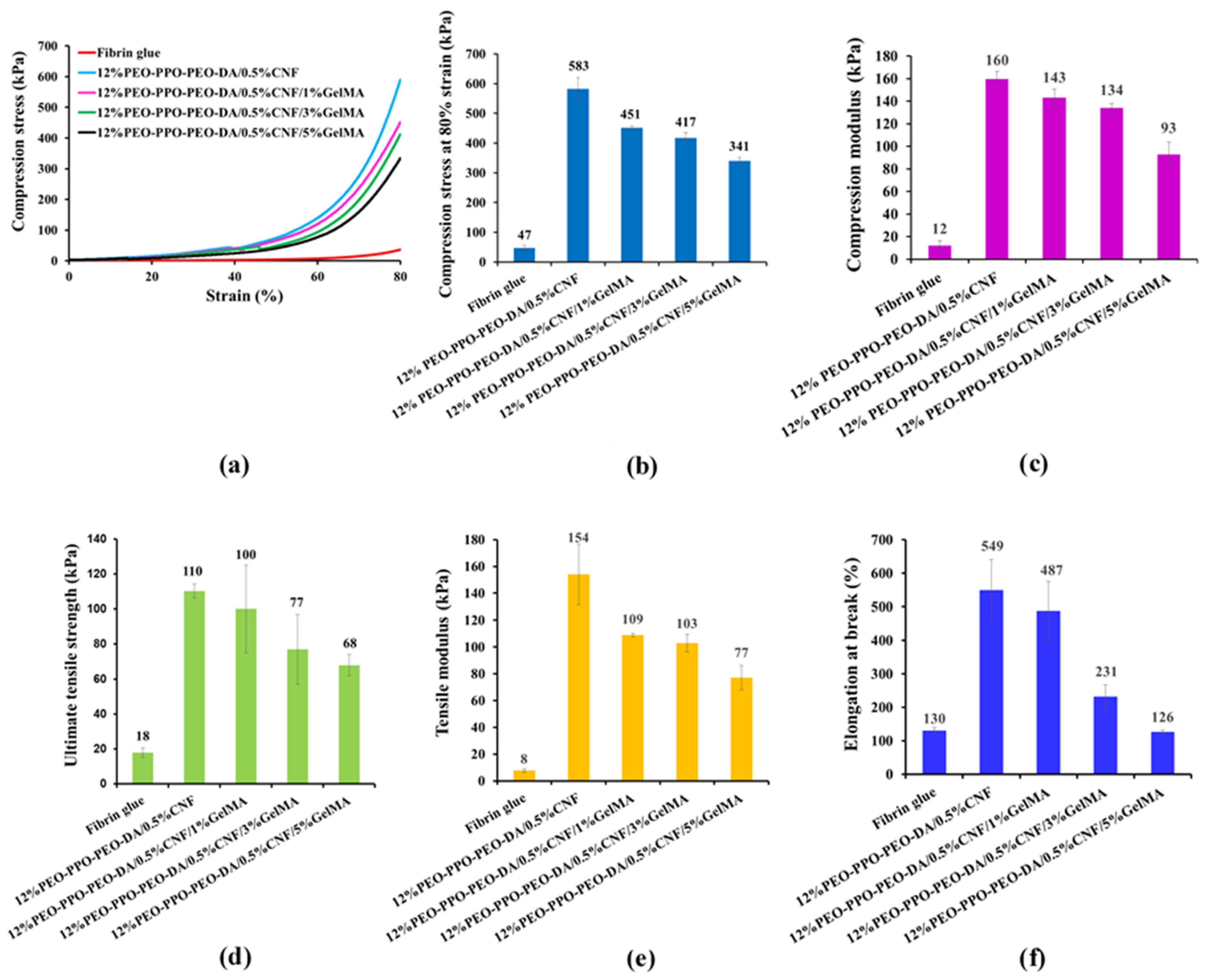
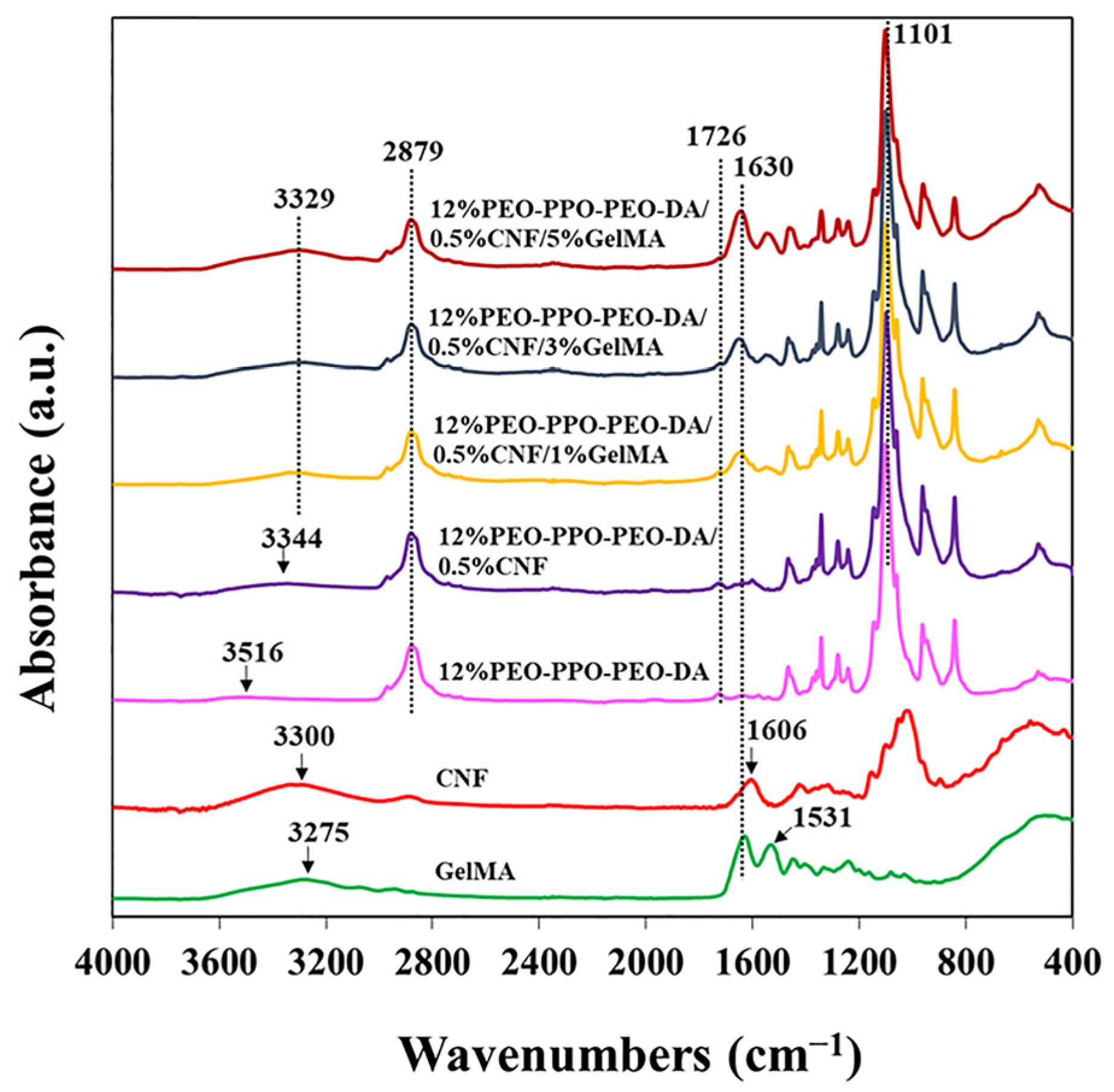
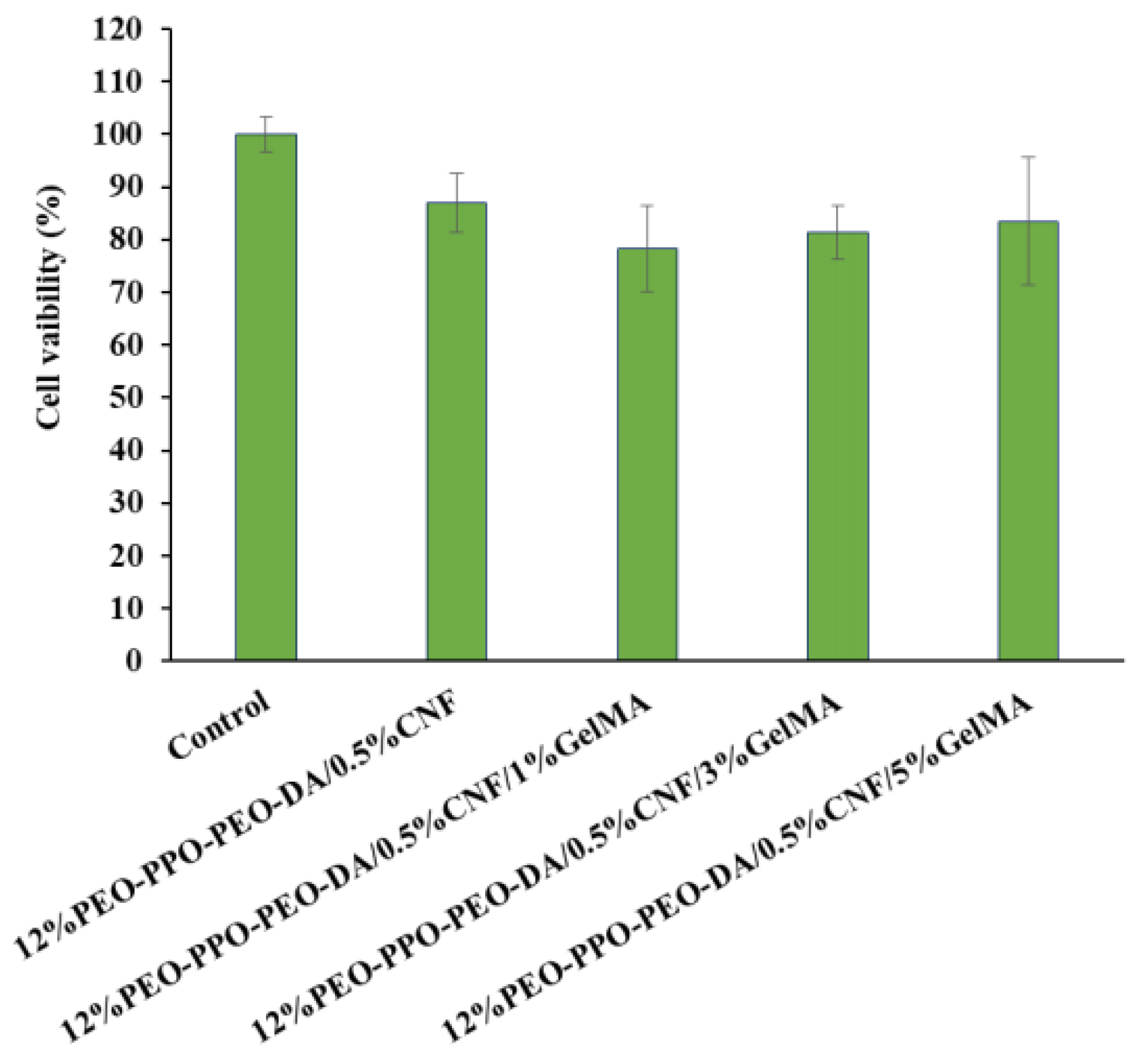
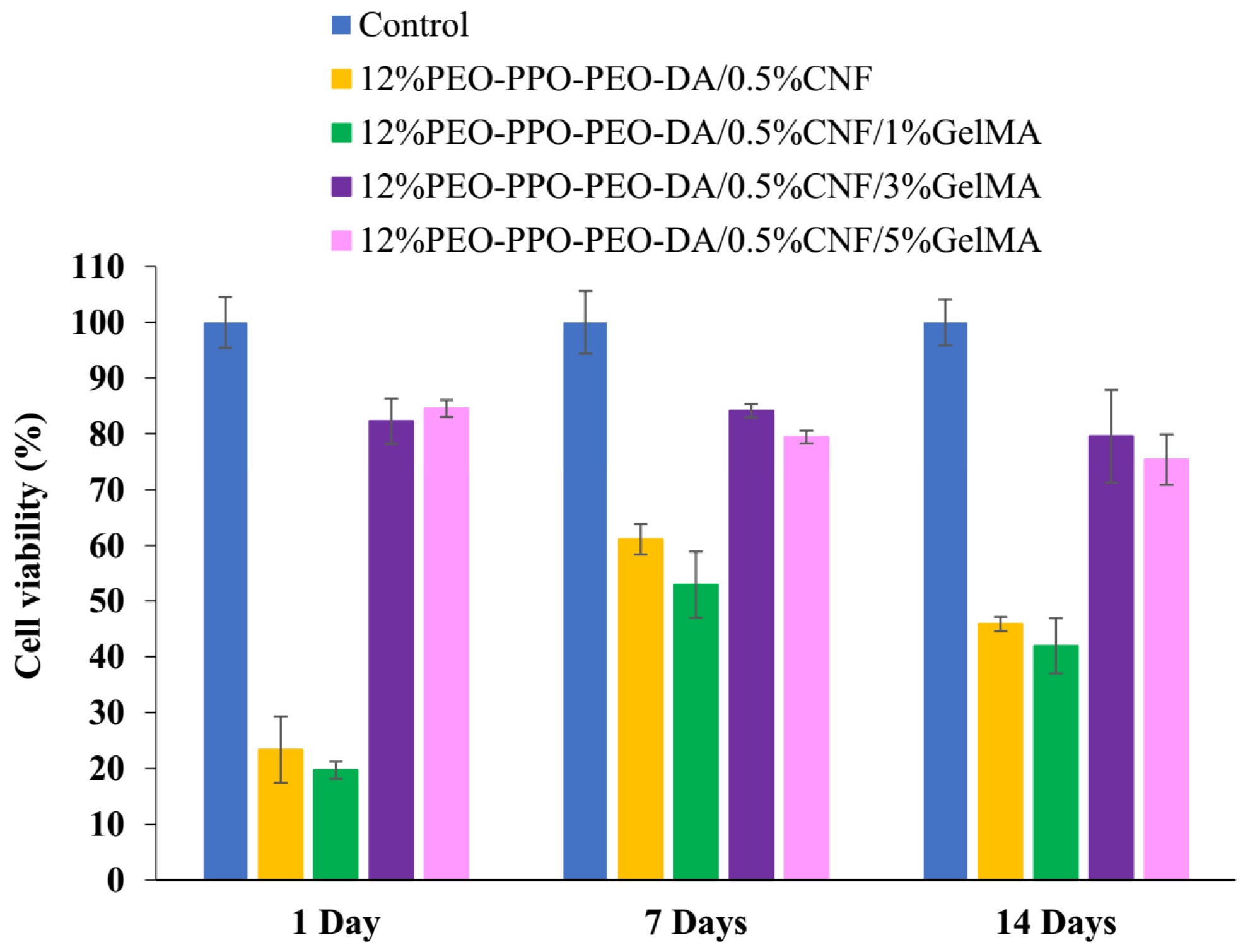

| Sample | Amorphous Region Peak Intensity (a.u.) | Crystalline Region Peak Intensity (a.u.) | CrI (%) |
|---|---|---|---|
| CP | 5441 | 6725 | 19.10 |
| BCP | 5070 | 9550 | 46.91 |
| CNF | 3820 | 6663 | 42.67 |
| Formulations | Pore Size Diameter (Surface) (µm) | Pore Size Diameter (Cross-Section) (µm) | Porosity (%) |
|---|---|---|---|
| 12%PEO-PPO-PEO-DA | 14–128 | 12–141 | 93.11 ± 3.14 |
| 12%PEO-PPO-PEO-DA/0.3%CNF | 19–128 | 14–168 | 79.54 ± 3.13 |
| 12%PEO-PPO-PEO-DA/ 0.5%CNF | 12–118 | 16–140 | 74.48 ± 1.74 |
| 12%PEO-PPO-PEO-DA/ 0.7%CNF | 11–112 | 9–81 | 64.92 ± 4.00 |
| Materials | Compression Strength (kPa) | Compression Modulus (kPa) | Tensile Strength (kPa) | Tensile Modulus (kPa) | Elongation at Break (%) | References |
|---|---|---|---|---|---|---|
| Stearyl methacrylate (C18M)/silk fibroin hydrogel | 17.10 | / | / | / | / | [23] |
| Nano-hydroxyapatite/ poly(L-glutamic acid)-dextran hydrogel | 51.00 | / | / | / | / | [24] |
| Hydroxyapatite coated a chitosan-polyvinyl alcohol hydrogel | 66.90 | 109.90 ± 7.00 | / | / | / | [25] |
| Peptide loaded oxidized dextran/GelMA hydrogel | 110.00 | 136.50 ± 11.60 | / | / | / | [26] |
| Genipin cross-linked gelatin hydrogel | 70.00 | 300.00 ± 30.00 | 16.00 | 36.59 ± 3.98 | 46.00 | [27] |
| Fibrin glue | 46.71 ± 8.87 | 11.98 ± 4.45 | 17.99 ± 2.68 | 7.69 ± 1.30 | 129.28 ± 8.78 | This work |
| 12%PEO-PPO-PEO-DA hydrogel | 398.01 ± 26.82 | 120.86 ± 9.47 | 57.32 ± 4.25 | 96.68 ± 9.61 | 450.64 ± 37.40 | |
| 12%PEO-PPO-PEO-DA/ 0.3%CNF hydrogel | 428.64 ± 30.49 | 142.87 ± 2.48 | 69.60 ± 17.24 | 139.47 ± 16.49 | 499.34 ± 53.95 | |
| 12%PEO-PPO-PEO-DA/ 0.5%CNF hydrogel | 582.55 ± 38.18 | 159.54 ± 7.06 | 110.24 ± 4.00 | 154.10 ± 22.60 | 548.97 ± 92.06 | |
| 12%PEO-PPO-PEO-DA/ 0.7%CNF hydrogel | 518.42 ± 56.27 | 150.02 ± 15.70 | 78.44 ± 5.42 | 148.28 ± 4.39 | 566.07 ± 16.40 | |
| Hydrogel scaffold requirement | ≥100 | ≥100 | ≥50 | ≥100 | ≥100 | [28] |
| Formulations | Gel Fraction (%) | Water Uptake (%) | Water Swelling (%) |
|---|---|---|---|
| 12%PEO-PPO-PEO-DA | 83.72 ± 0.38 | 86.53 ± 0.03 | 642.59 ± 1.60 |
| 12%PEO-PPO-PEO-DA/0.3%CNF | 82.85 ± 0.78 | 86.18 ± 0.30 | 623.80 ± 16.00 |
| 12%PEO-PPO-PEO-DA/ 0.5%CNF | 82.59 ± 1.00 | 86.16 ± 0.14 | 622.80 ± 7.24 |
| 12%PEO-PPO-PEO-DA/ 0.7%CNF | 81.30 ± 0.89 | 86.07 ± 0.22 | 617.97 ± 11.33 |
| Formulations | Pore Size Diameter (Surface) (µm) | Pore Size Diameter (Cross-Section) (µm) | Porosity (%) |
|---|---|---|---|
| 12%PEO-PPO-PEO-DA/ 0.5%CNF | 12–118 | 16–140 | 74.48 ± 1.74 |
| 12%PEO-PPO-PEO-DA/ 0.5%CNF/1%GelMA | 11–97 | 16–138 | 92.60 ± 0.87 |
| 12%PEO-PPO-PEO-DA/ 0.5%CNF/3%GelMA | 13–92 | 9–126 | 95.62 ± 0.87 |
| 12%PEO-PPO-PEO-DA/ 0.5%CNF/7%GelMA | 12–83 | 8–114 | 98.63 ± 0.88 |
| Formulations | Gel Fraction (%) | Water Uptake (%) | Water Swelling (%) |
|---|---|---|---|
| 12%PEO-PPO-PEO-DA/ 0.5%CNF | 82.59 ± 1.00 | 86.16 ± 0.14 | 622.80 ± 07.24 |
| 12%PEO-PPO-PEO-DA/ 0.5%CNF/1%GelMA | 82.39 ± 0.51 | 86.19 ± 0.51 | 624.77 ± 27.38 |
| 12%PEO-PPO-PEO-DA/ 0.5%CNF/3%GelMA | 82.29 ± 0.28 | 87.14 ± 1.03 | 680.62 ± 61.03 |
| 12%PEO-PPO-PEO-DA/ 0.5%CNF/7%GelMA | 82.05 ± 0.62 | 87.95 ± 0.23 | 730.31 ± 16.00 |
| Materials | Compression Strength (kPa) | Compression Modulus (kPa) | Tensile Strength (kPa) | Tensile Modulus (kPa) | Elongation at Break (%) | References |
|---|---|---|---|---|---|---|
| Fibrin glue | 46.71 ± 8.87 | 11.98 ± 4.45 | 17.99 ± 2.68 | 7.69 ± 1.30 | 129.28 ± 8.78 | This work |
| 12% F127DA/0.5%CNF | 582.55 ± 38.18 | 159.54 ± 7.06 | 110.24 ± 4.00 | 154.10 ± 2.60 | 548.97 ± 92.06 | |
| 12% F127DA/0.5%CNF/ 1%GelMA | 451.33 ± 6.03 | 143.25 ± 7.60 | 100.00 ± 25.00 | 108.79 ± 1.37 | 487.00 ± 88.71 | |
| 12% F127DA/0.5%CNF/ 3%GelMA | 417.33 ± 17.90 | 133.96 ± 4.18 | 77.00 ± 20.00 | 102.87 ± 6.62 | 231 ± 36.45 | |
| 12% F127DA/0.5%CNF/ 5%GelMA | 340.67 ± 11.59 | 92.94 ± 10.75 | 68.00 ± 6.00 | 77.18 ± 8.96 | 126 ± 6.56 | |
| Hydrogel scaffold requirements | ≥ 100 | ≥ 100 | ≥ 50 | ≥ 100 | ≥ 100 | [28] |
Disclaimer/Publisher’s Note: The statements, opinions and data contained in all publications are solely those of the individual author(s) and contributor(s) and not of MDPI and/or the editor(s). MDPI and/or the editor(s) disclaim responsibility for any injury to people or property resulting from any ideas, methods, instructions or products referred to in the content. |
© 2023 by the authors. Licensee MDPI, Basel, Switzerland. This article is an open access article distributed under the terms and conditions of the Creative Commons Attribution (CC BY) license (https://creativecommons.org/licenses/by/4.0/).
Share and Cite
Jeencham, R.; Tawonsawatruk, T.; Numpaisal, P.-o.; Ruksakulpiwat, Y. Reinforcement of Injectable Hydrogel for Meniscus Tissue Engineering by Using Cellulose Nanofiber from Cassava Pulp. Polymers 2023, 15, 2092. https://doi.org/10.3390/polym15092092
Jeencham R, Tawonsawatruk T, Numpaisal P-o, Ruksakulpiwat Y. Reinforcement of Injectable Hydrogel for Meniscus Tissue Engineering by Using Cellulose Nanofiber from Cassava Pulp. Polymers. 2023; 15(9):2092. https://doi.org/10.3390/polym15092092
Chicago/Turabian StyleJeencham, Rachasit, Tulyapruek Tawonsawatruk, Piya-on Numpaisal, and Yupaporn Ruksakulpiwat. 2023. "Reinforcement of Injectable Hydrogel for Meniscus Tissue Engineering by Using Cellulose Nanofiber from Cassava Pulp" Polymers 15, no. 9: 2092. https://doi.org/10.3390/polym15092092
APA StyleJeencham, R., Tawonsawatruk, T., Numpaisal, P.-o., & Ruksakulpiwat, Y. (2023). Reinforcement of Injectable Hydrogel for Meniscus Tissue Engineering by Using Cellulose Nanofiber from Cassava Pulp. Polymers, 15(9), 2092. https://doi.org/10.3390/polym15092092







